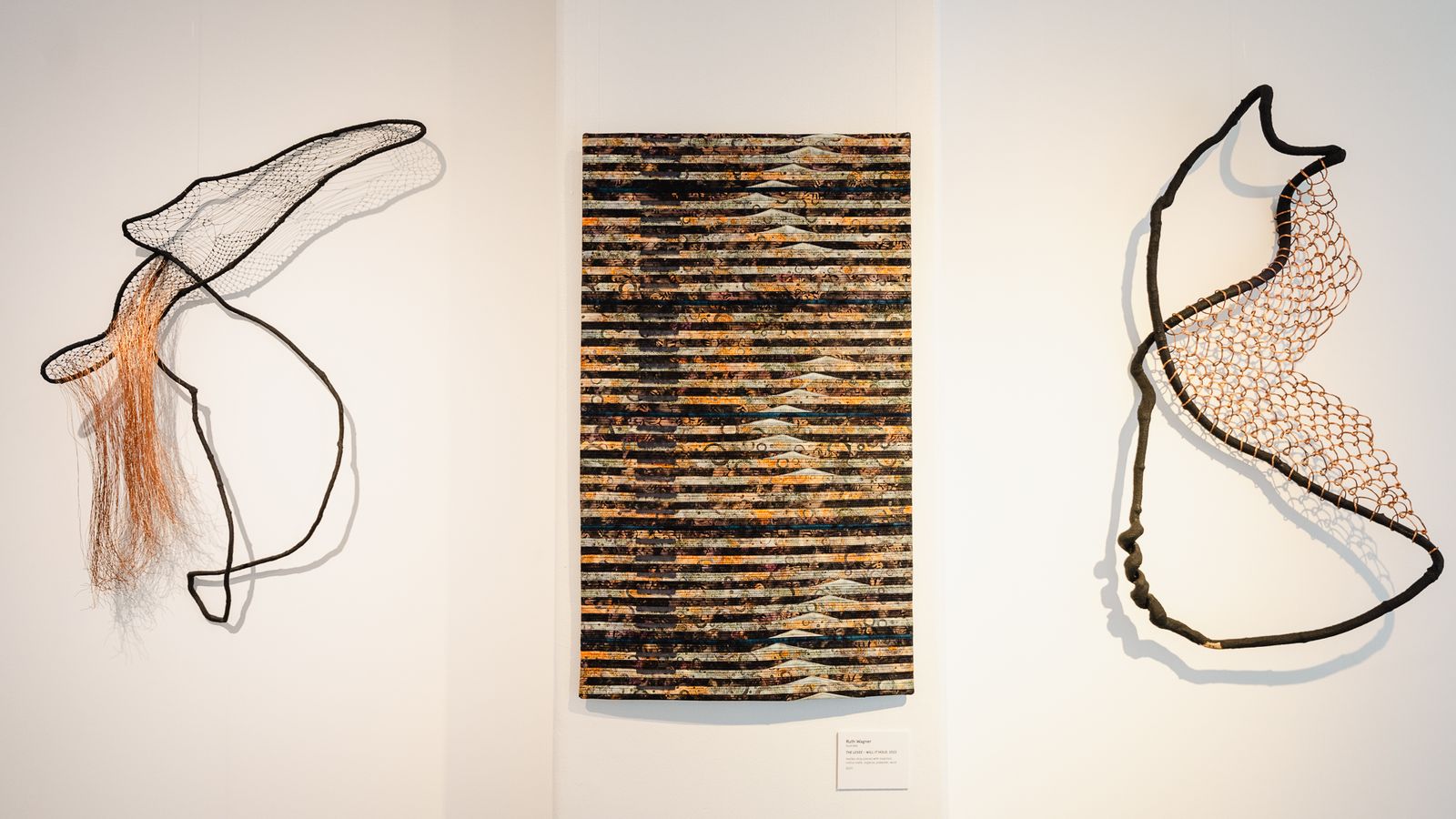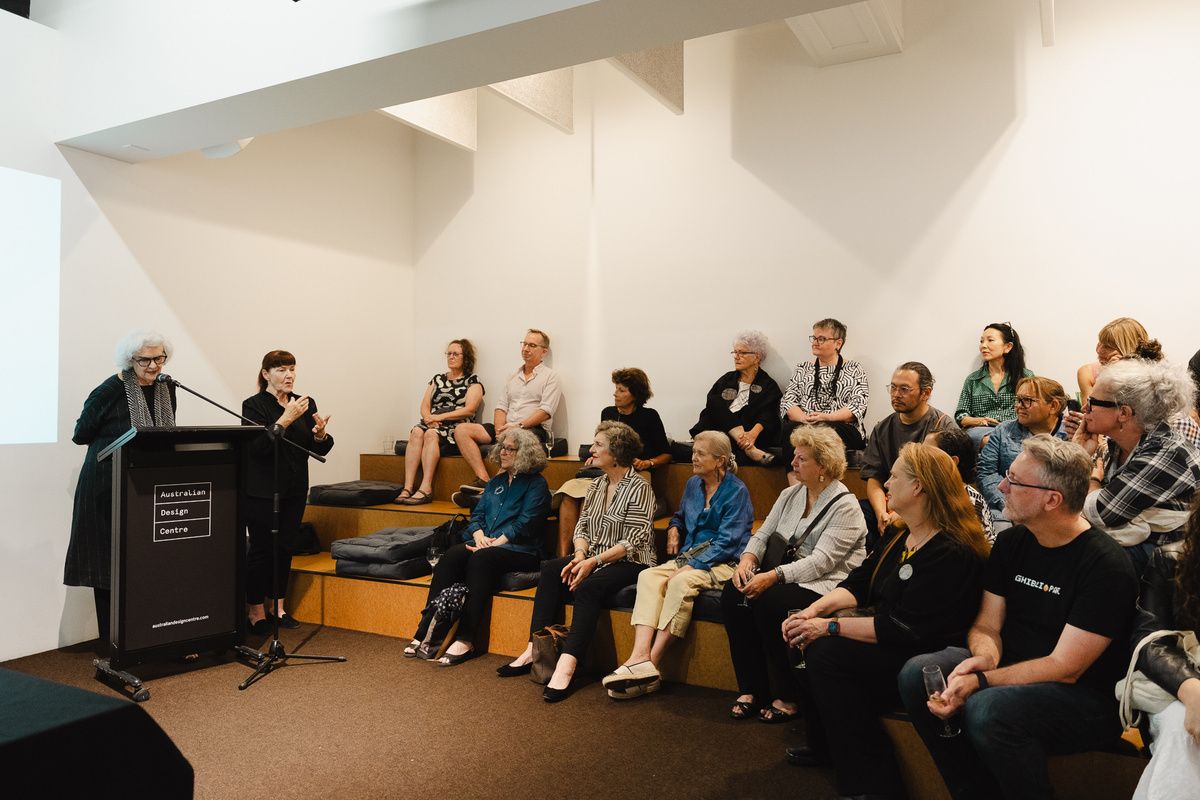Speech: International Art Textile Biennale 2023 Opening Address

Curator, weaver and academic, Liz Williamson spoke at the launch of the International Art Textile Biennale 2023 and discussed the vibrancy of contemporary textile based art on 8 February 2024. Her speech is below:
I’m privileged to live in a country with such a rich Indigenous fibre art and weaving tradition.
The descriptor of the International Art Textile Biennale (IATB) 2023 organised by Fibre Arts Australia states that this exhibition celebrates the vibrant and evolving world of contemporary art textiles.
It also states that ……. Now textile-based art has become a powerful and accessible medium in the examination of identity, society, and politics.
As a practitioner, I agree that the textiles world is vibrant – but am totally immersed in that world and a little biased.
Many people feel that textiles do have a significantly higher profile today than a few of years ago – that artists working with textile or fibrous materials are producing works that are vibrant, engaging, relevant, innovative, experimental etc and that within the art, craft and design arena, textiles are experiencing a resurgence and are hot!
To illustrate this resurgence, the International Art Textile Biennale is one of several significant curated or award exhibitions that opened in Australia 2023 –the Jam Factory in Adelaide (New Exuberance), UNSW Galleries (Pliable Planes) and Tamworth Regional Gallery (5th Tamworth Textile Triennial) - all textiles exhibitions touring nationally and Wangaratta Art Gallery’s contemporary textiles award exhibition was shown mid-year.
In October 2023, the World Craft Council Australia (which I’m involved in as president), held an online discussion on contemporary textiles and I made a list of 42 textiles exhibitions that I was aware of being shown nationally in 2023.
Textiles are used by so many to express a particular view of the world – there are 35 examples of that in the gallery; all using textile materials to examine identity, society, the environment, architecture, politics and comment on issues.
But haven’t textiles always been used to express ideas and to reflect our world?
Some feel this is a recent shift but historically, for thousands of years people have used textiles to express their ideas and to reflect their world but there are numerous examples of ancient and historical textiles recording -
- ideas, events (AIDS quilts), places (tea towels), wars (Bayeux tapestry) and politics (union banners).
- portraits being woven as in early Egyptian tapestries.
- pictorial wall hanging being woven for European Renaissance castles.
- environments, communities and village life being depicted eg embroideries made in India and many other countries.
- textiles being made for specific communities with specific motifs, colours and patterns - like the early Indian block printed textiles that were found in Egypt; Fustat fragments and carbon dates to the 9 to 15th centuries.
And this is just a brief list!
I feel that for as long as textiles have been made, the makers have been expressing their ideas, creating unique works, and using various textile mediums to describe what they saw around them and to interpret their world. And over the years they have used numerous names to describe what they did.
Textiles, fibre art, art textiles, textile art, textile-based art, and that’s before describing the actual method of creating the textiles eg weaver, embroiderer, batik artist, printer, dyer etc
In the 1960 it was definitely fibre art and the 1970’s and 80’s saw remarkable shifts in what people did with textile materials.
I began weaving in the late 1970’s and learnt about contemporary practice from key fibre art books namely - ‘Beyond Craft: the art fabric’ (1973) by Jack Lenor Larsen and Mildred Constantine, traced the fibre art movement through the 60’s; its introduction stated that ‘the art fibre is one of the robust, vital arts of our time ….. the artists who create with fiber have united creativity and intuition, principles and skills to form an aesthetic entity’.
‘The art fabric: mainstream’ (1981) by the same authors, begins with a poem titled ‘the art fabric’.
Single fibers are like letters of an alphabet,
with them one can form words and sentences then create prose and poetry,
like a single letter a fiber has characteristics
which may be sequenced towards an infinity of forms
this unlimited potential for interpretation
is basic to artists working in fibre.
These books documented the work of many famous artists – Ed Rossbach, Lenore Tawney, Magdalena Abakanowicz (Tate Modern held an exhibition of her works November 2022 to May 2023), Olga de Amaral, Chisto, Peter and Ritzi Jacobi and a favourite, Sheila Hicks, now 89 and still active, exhibiting regularly with work in the current NGV triennial.
In Australia, ‘The artist craftsman in Australia’ was published about the same time and showed the fibre work of Pru Medlin, Jutta Feddersen, Ewa Pachucka, Mona Hessing, Fay Bottrell, Heather Dorrough and Vivienne Pengilley, - all working and discovering their voice with fibre. Sadly, most not as well-known as the internationals.
Whatever it’s called - Fibre art, contemporary art textiles, Art Textiles, textile-based art, Art Fabric or just plain textiles, the thing is that these artists use textile materials to give expression to their ideas. And, as is shown by this exhibition, what these materials are is extremely diverse – the exhibition descriptor states ‘Seated beside the familiar textile (materials) are a myriad of unconventional companions - rabbit skin, paper-pulp, concrete, flax, old woollen blankets, stringybark, spider egg cases, recycled plastics, foraged vines, recycled electrical copper wire, charcoal, reclaimed ceramics, fluorite, amethyst, business tie linings, doilies, and off-cuts of previous artworks.
Works that use diverse and unexpected materials can ‘push the boundaries of textile art’. As Anni Albers wrote in 1982 that - we can use any material to make our ideas visible and any material can take on the burden of what has been brewing in our consciousness or subconsciousness, in our awareness or in our dreams.
International Art Textile Biennale 2023 – more than half the exhibitors are Australian (21) with 3 from the United Kingdom, 2 from South Korea and one each from Lithuania, Japan, India, Germany, France and USA. Several are Sydney based and may be here this evening. - Laura Bishop, Tina Fox, Brenda Livermore, Irene Manion and Catriona Pollard.
And Australian won three of the four award – Josephine Jakobi, Claudia Mazzotta and Brenda Livermore.
Congratulations everyone on your work in this exhibition, to Fibre Arts Australia for organising the event and to Australian Design Centre for presenting the interesting and compelling International Art Textile Biennale 2023.
Liz Williamson
Sydney, 8 February 2024

Liz Williamson, 2024, Exhibition View. Photo by Amy Piddington
